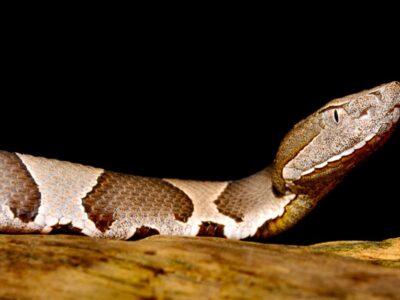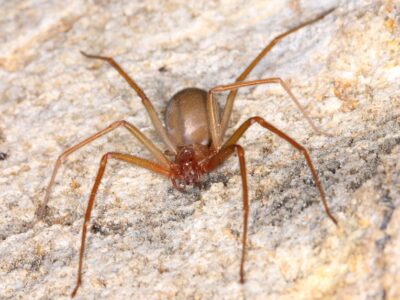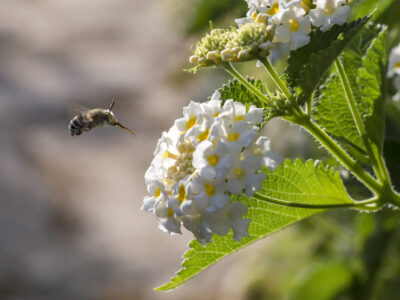The state of Georgia in the United States has a varied landscape with rivers, mountains, coastal plains, marshes, and forests. So, it’s not surprising to learn that there are a variety of animals that make their home in this southern state. As an example, there are 90 plus species of mammals living in Georgia.
Some of the most notable members of the wildlife community in this southern state include black bears, fox squirrels, ticks, bottlenose dolphins, white-tailed deer, big brown bats, and Georgia native–the flying squirrel.
The Official Animals of Georgia
Over the years, Georgia has recognized many animals as state symbols and has 13 official state animals.
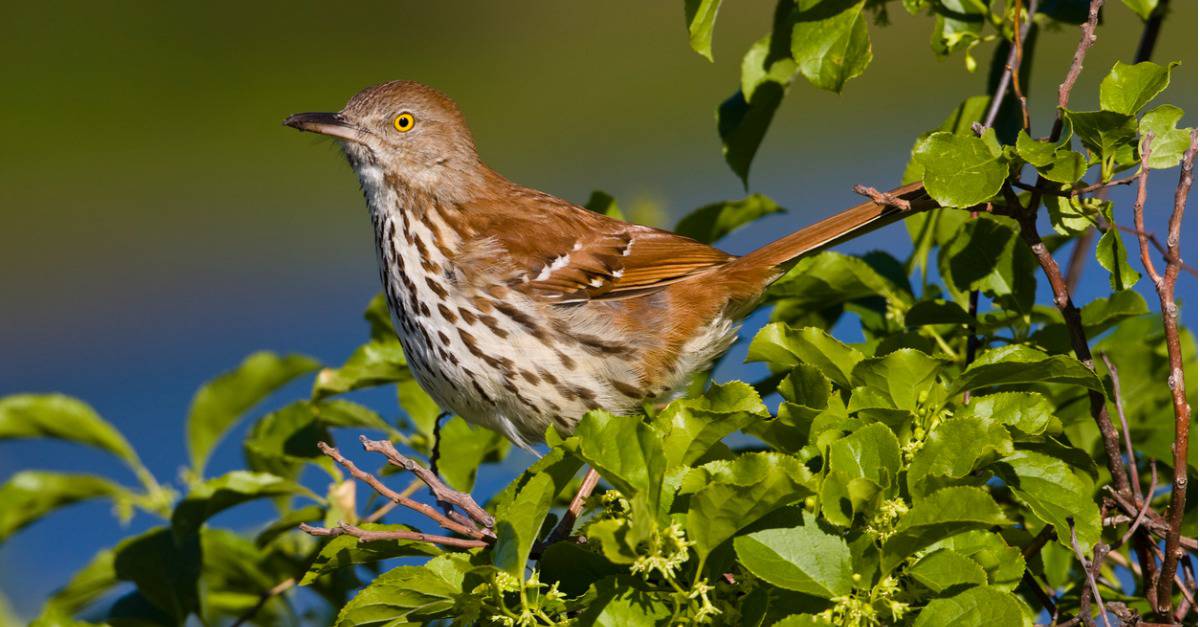
The brown thrasher forages through ground debris for insects.
©iStock.com/johnandersonphoto
Official Bird of Georgia: Brown Thrasher
In 1970, Georgia’s legislature officially recognized the brown thrasher (Toxostoma rufum) as its state bird. This bird is a common sight around Georgia with its dark brown feathers, long tail, and slightly curved beak. This bird earned its name by the thrashing action it uses to forage through weeds, grass, and other ground debris in search of insects.
Official Game Bird of Georgia: Bobwhite Quail
Georgia was known as the quail-hunting capital of the world in the early 1900s. In 1970, the (northern) bobwhite quail (Toxostoma rufum), also called a partridge, became the state gamebird. A small, pudgy brown bird, it has markings unique to each gender: the mail has a white throat and a white stripe above the eyes; the female has a light brownish-yellow throat patch and eye stripes.
Official Fish of Georgia: Largemouth Bass
In 1970, the largemouth bass (Micropterus salmoides) was made the official state fish of Georgia. This fish has olive gray scales and populates warm water lakes, streams, and rivers. The largest largemouth bass was caught in 1932 and weighed a little over 22 pounds!
Official Butterfly of Georgia: Eastern Tiger Swallowtail
In 1988, the eastern tiger swallowtail (Papilio glaucus) was recognized as the official state butterfly of Georgia. This butterfly is a common sight in the state displaying bright yellow wings and black stripes. It symbolizes beauty and new beginnings.
Official Mammal of Georgia: White-Tailed Deer
In 2015, the white-tailed deer (Odocoileus virginianus) became the state mammal of Georgia due to the efforts of a group of local elementary school students. This deer, with its warm brown fur and bright white tail lives in forests and marshlands throughout the state. The IUCN Red List conservation status of the white-tailed deer is Least Concern with a stable population.
Official Amphibian of Georgia: Green Tree Frog
In 2005, the green tree frog (Hyla cinerea) became the official state amphibian of Georgia. Georgia is home to 85 different species of amphibians. Green tree frogs are lime green with a bright white stripe on each side of their smooth body. This frog lives throughout the state and can be heard chirping and peeping throughout the spring and summer months. The male green tree frog is normally louder and chirps more often than the female frog.
Official Insect of Georgia: European honey bee
The official Georgia state insect is the European honey bee. Adult European honey bees are “thread-waisted” with a restricted connection between their thorax and abdomen. The “pollen sac,” situated on both hind legs, is another component which differentiates these honey bees.
Official Reptile of Georgia: Gopher Tortoise
A species of tortoise in the family Testudinidae, the gopher tortoise is native the the southeastern United States. Its scientific name is Gopherus Polyphemus. In fact, the only tortoises native to North America are in the genus Gopherus. While it is the state reptile of Georgia, it is the state tortoise of Florida!
Sadly, it is threated by predation and loss of habitat. This situation is particulary alarming because the gopher tortoise is a keystone species, meaning that other species in the ecosystem depend on it. In the case of the gopher tortoise, around 360 other species find shelter in the burrows it digs.
Where to Find the Top Wild Animals in Georgia
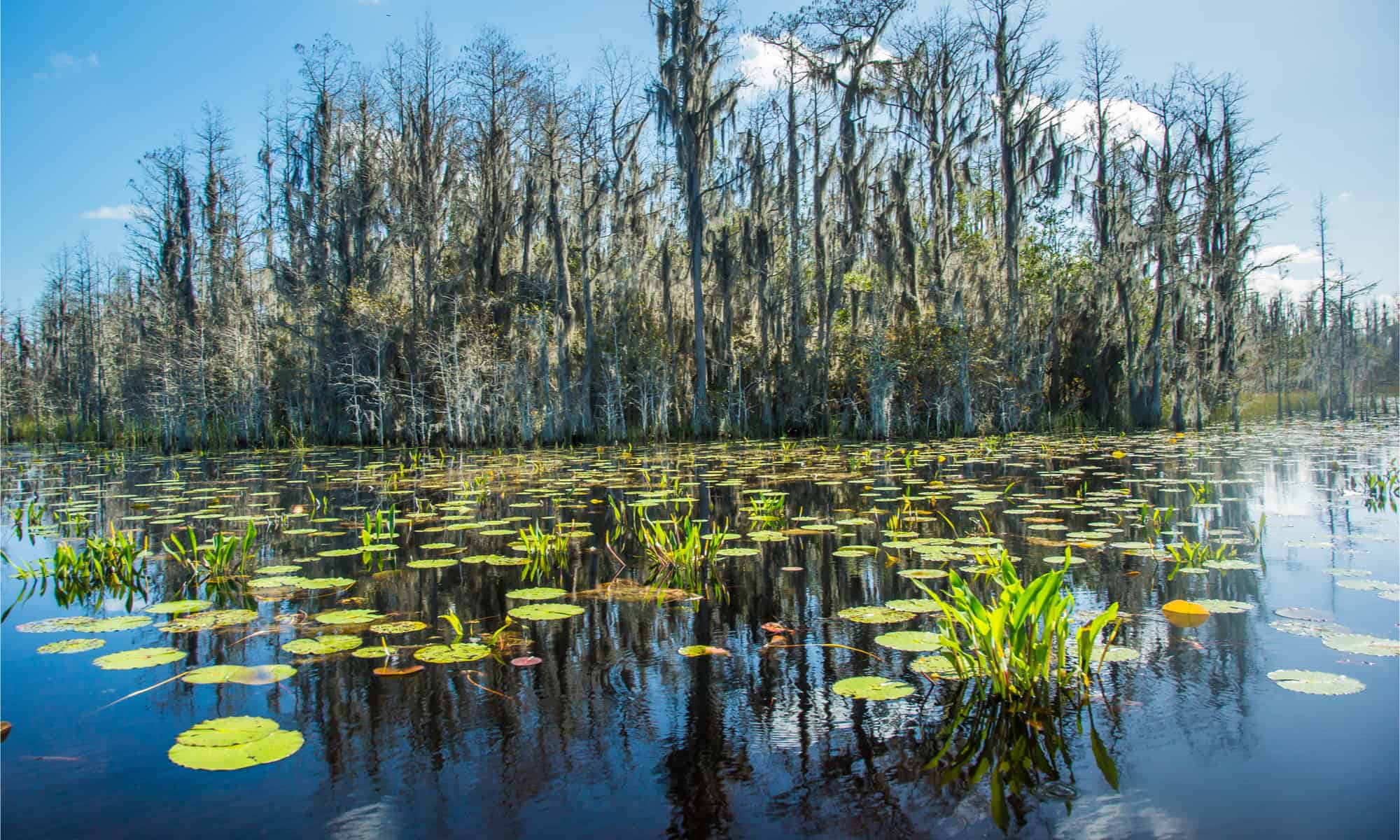
Green lilly pads in the Okefenokee swamp National Wildlife Refuge near Folkston, Georgia
©Bob Pool/Shutterstock.com
The sort of wildlife a visitor sees in Georgia depends on the specific habitat. When someone visits a swampy area such as Okefenokee Swamp or Lake Blackshear, they may see American alligators, sandhill cranes, river otters, beavers, and sea turtles among many other animals.
The forests of Georgia are home to many mammals such as raccoons, foxes, white-tailed deer, weasels, black bears, coyotes, and big brown bats.
The coastal plains of Georgia are inhabited by snakes including the Florida Pine snake and the cottonmouth snake. Some brown snakes can also be found in Georgia, as well as some water snakes and black snakes. Fox squirrels, quail, wild turkeys, and rabbits can all be found on the coastal plains.
Someone visiting the mountains in Georgia may see salamanders, bobcats, gray foxes, woodchucks, and lizards to name a few.
Travel to the coast of Georgia on the Atlantic Ocean and a visitor is likely to observe sea turtles, seagulls, dolphins, and maybe even a West Indian manatee! These manatees are sometimes called sea cows because of the time they spend looking for food and eating. The best time to see manatees off the coast of Georgia is between the months of April and October.
Recommended locations for wildlife sighting include:
- Tribble Mill Park
- Phinizy Center and Nature Park
- Chattahoochee River National Park
- Cannon’s Point Preserve
- Dauset Trails
- Panola Mountain State Park
Where to Find Animals in Georgia Zoos

Zoo Atlanta entrance
©Rob Hainer/Shutterstock.com
Another great way to learn about Georgia’s native wildlife, as well as animals from other places, is to visit a zoo. Some suggestions include:
- Chehaw Park and Zoo in Albany, Georgia, opened in 1937 as a state park but now has a zoo and splash park and other attractions on 800 acres. The zoo houses 234 specimens representing over 73 different species. The zoo was designed by naturalist Jim Fowler of television’s Wild Kingdom
- Zoo Atlanta began in 1899 with a traveling menagerie that stopped and stayed. It has grown enormously since then into a major conservation organization. For a long time, its most famous resident was Willie B, a gorilla. Now the collection is enhanced by a pair of pandas!
- Georgia Aquarium has not only multiple fish species, but also alligators, penguins, beluga whales, otters, and tortoises among others.
- Yellow River Wildlife Sanctuary, which has a variety of forest animals and many others such as a Bison herd, peacocks, pigs, albino wallabies, Babydoll sheep, Fallow deer, ring-tailed lemurs, alpacas, and the animals in the petting zoo.
The Most Dangerous Animals in Georgia Today
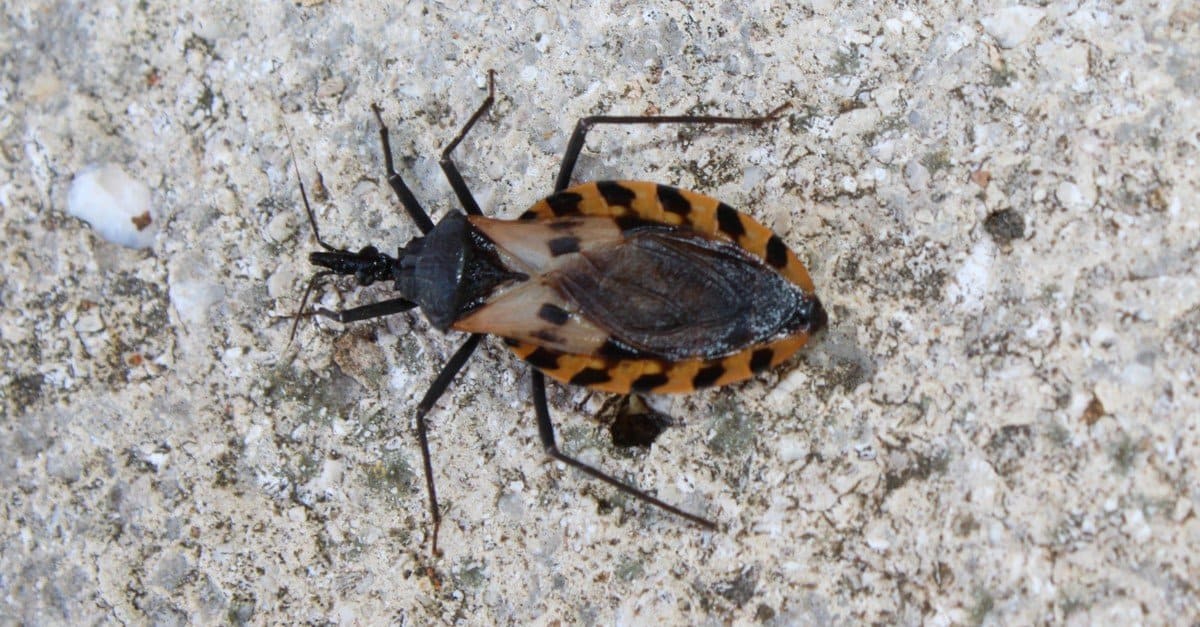
Assassin bugs or “kissing bugs” get their names from their habit of biting humans on the face near the lips while they sleep.
©Vanessa Becker-Miller/Shutterstock.com
Like most other states, Georgia has its share of dangerous animals. As a note, most animals can become dangerous if they feel their young are being threatened. Also, some animals become dangerous if a human wanders (either knowingly or unknowingly) into their territory. Remember, showing respect for all of the wildlife in an area is always a good idea. Check out some of the most dangerous animals in Georgia below.
The eastern diamondback rattlesnake is one of the most dangerous animals in Georgia. In fact, it’s the biggest venomous snake in America. While some snakes prefer to hide or escape a threat, this snake is quick to show aggression and bite. An adult eastern diamondback rattlesnake is at the top of the food chain with no natural predators.
The venom of this snake contains hemotoxin which kills tissue and red blood cells. Their venom allows them to quickly kill prey such as birds, rabbits, and rodents, including rats. People who’ve been bitten by this snake describe it as very painful due to its long fangs. However, death is the rarest result of an eastern diamondback rattlesnake bite. This is because the antivenom is readily available and effective. It’s important to get medical attention right away if bitten by this snake.
Another animal considered one of the most dangerous in Georgia is the black widow spider. These spiders are black with strange red markings on their abdomen. They make their homes in garages, sheds, and basements. It’s common for them to build webs in dark places where there’s very little human activity. People who are bitten by black widow spiders usually stumble upon their web by accident. The venom of this spider has a neurotoxin that causes sweating, stiff muscles, abdominal cramps, and pain. Though medical treatment is needed for this spider’s bite, it is rarely fatal.
Snapping turtles are also considered some of the most dangerous animals in Georgia. They live in freshwater ponds, lakes, and other bodies of water. These turtles can become aggressive when they are on land. This is because they feel more vulnerable to threats when they’re out of the water. These turtles can weigh up to 35 pounds and have a sharp, cutting edge on their mouth capable of biting a person’s finger off. The best thing to do if someone sees a snapping turtle on a trail or near a pond is to move away from it and leave it alone.
The copperhead snake is similar to the eastern diamondback rattlesnake. The bite of this snake is very painful, but death from its venom is the rarest result because their venom is not very potent. It’s important to note that these snakes are aggressive and choose to defend their territory instead of moving away from an encounter. Other types of snakes hide the moment they see a human in the area. Copperhead snakes can grow to be three feet long and are usually out in the evening searching for rodents, toads, and other prey. A person who is bitten by a copperhead snake needs to seek medical treatment as soon as possible.
The fire ant, genus Solenopsis, is dangerous because of its venomous bite, which causes stinging that feels like fire. It is not fatal, but it is very painful. The frightening news is that there are over 200 species of these insects! The head, thorax, and abdomen, along with three pairs of legs and a pair of antennae, are the three main body parts of mature fire ants, just like the bodies of all other typical mature insects. The worker ants range in size from 2 to 6 mm (0.079 to 0.236 in) and are blackish to reddish. They typically create nests or mounds roughly one foot high in grassy settings like pastures and lawns. Fire ant nests don’t have a single opening like most anthills, and the slope is covered in ants.
The kissing-bug is a member of the subfamily Triatominae of the family Reduviidae. It’s bite is painless, but it transmits a parasite that causes the Chagas disease, also known as American trypanosomiasis. Symptoms include aches, fever, swelling around the bite (usually near the lips), and fever. But one of the most identifiable symptoms of this phase is puffy eyelids. There are two phases of the disease, and the second phase might be in remission for years. Chagas disease is also not well known, so it is not easily diagnosed correctly.
The Largest Animal in Georgia

North Atlantic right whales are docile, baleen whales that tend to keep close to the coast.
©iStock.com/6381380
The largest animal in Georgia is also the official marine animal: the North Atlantic Right Whale. This animal is approximately 42 to 53 feet long. It is dark grey to black with rough, white patches of skin on its head. The North Atlantic right whale is a docile, baleen whale that tends to keep close to the coast. Highly migratory, every winter many of these whales travel to their winter calving areas along the coasts of Georgia and Florida. It is actually the most endangered species of whale in the world; possibly fewer than 350 individuals are left today. One of the major threats to this whale is being struck by a vessel in busy shipping lanes.
Endangered Animals in Georgia
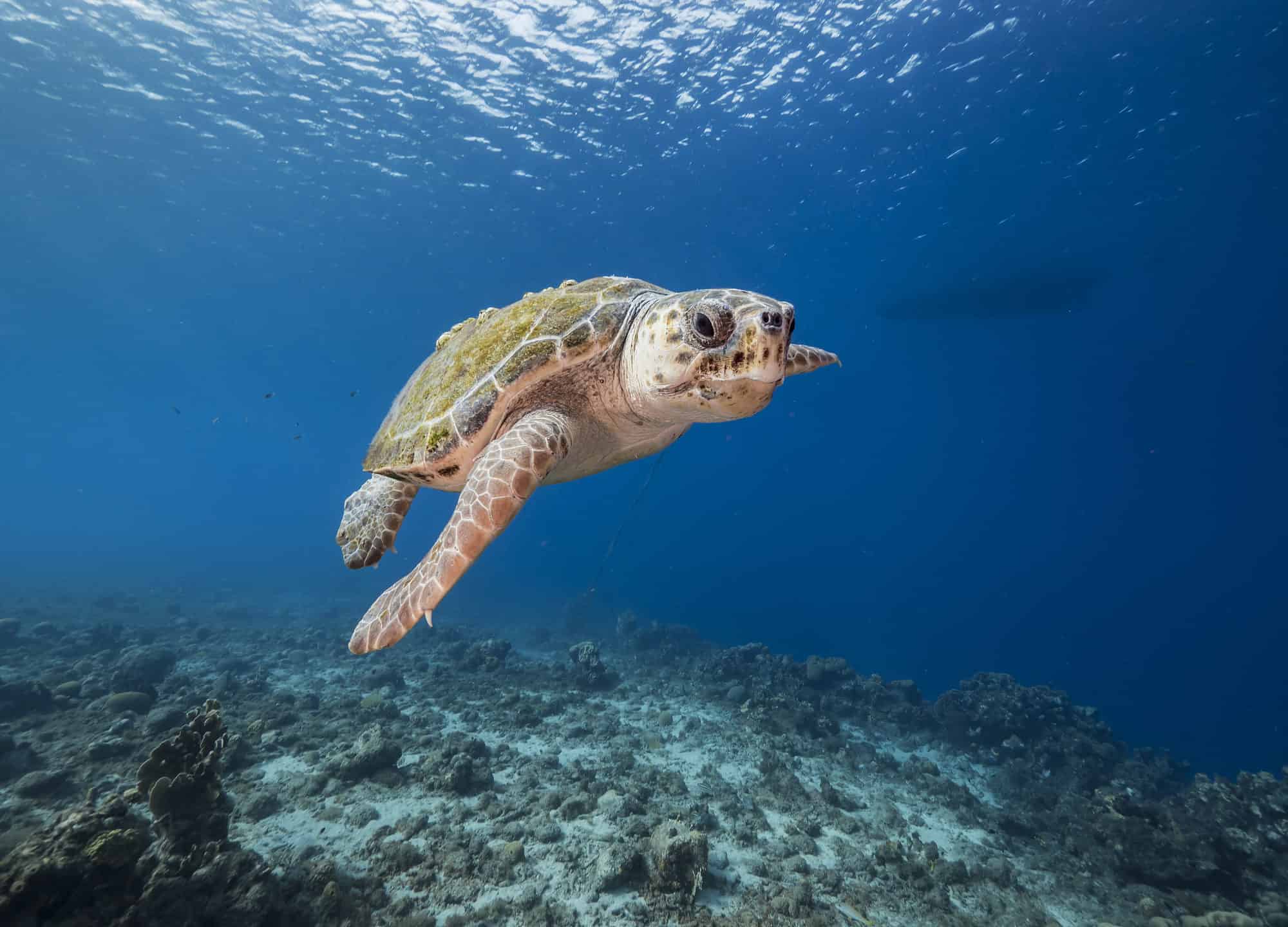
The Loggerhead Sea Turtle is an endangerd species that nests on Georgian’s barrier islands.
©iStock.com/naturepics_li
Georgia’s endangered animals include:
- Gray bat – These bats live in caves throughout the year and hibernate in the wintertime. They are on the endangered list because of loss of habitat due to flooding reservoirs. If a gray bat is pushed out of its cave during hibernation, it wastes a lot of its energy searching for a new cave and may die as a result.
- North Atlantic Right Whale – This whale has been on the endangered list since 1970. Scientists estimate the population of the North Atlantic right whale at less than 400. Threats to this whale include collisions with ships and other vessels as well as entanglement in commercial fishing nets.
- Reticulated Flatwoods Salamander – This salamander measures about five inches long and has a silver and black body featuring white spots. They are endangered due to habitat loss connected with the gradual drop in the water table. This decrease in water level can make it impossible for them to lay eggs.
- Loggerhead Sea Turtle – The large head of a loggerhead sea turtle gives it a strange appearance. These turtles nest on Georgia’s barrier islands. Their population is decreasing due to water pollution. Unfortunately, these sea turtles can die as a result of swallowing discarded plastic bags and fishing line.
- Red-cockaded woodpecker – This bird has shiny black feathers with a bright white pattern of spots. Males have a small stripe of red on their head. These birds live in pine trees in Georgia forests. They’re on the endangered list due to loss of their habitat.
- Shortnose Sturgeon – This fish lives in rivers in Georgia while spending some time in the Atlantic Ocean. They are dull gray in color and covered in five rows of scutes or bony plates. This fish can grow to be over 4 feet long. Their population is threatened by water pollution, dredging, and getting caught in commercial fishing nets meant for other fish. When a fish ends up in a net meant to capture another type of fish, it’s called bycatch.
The Rarest Animals in Georgia
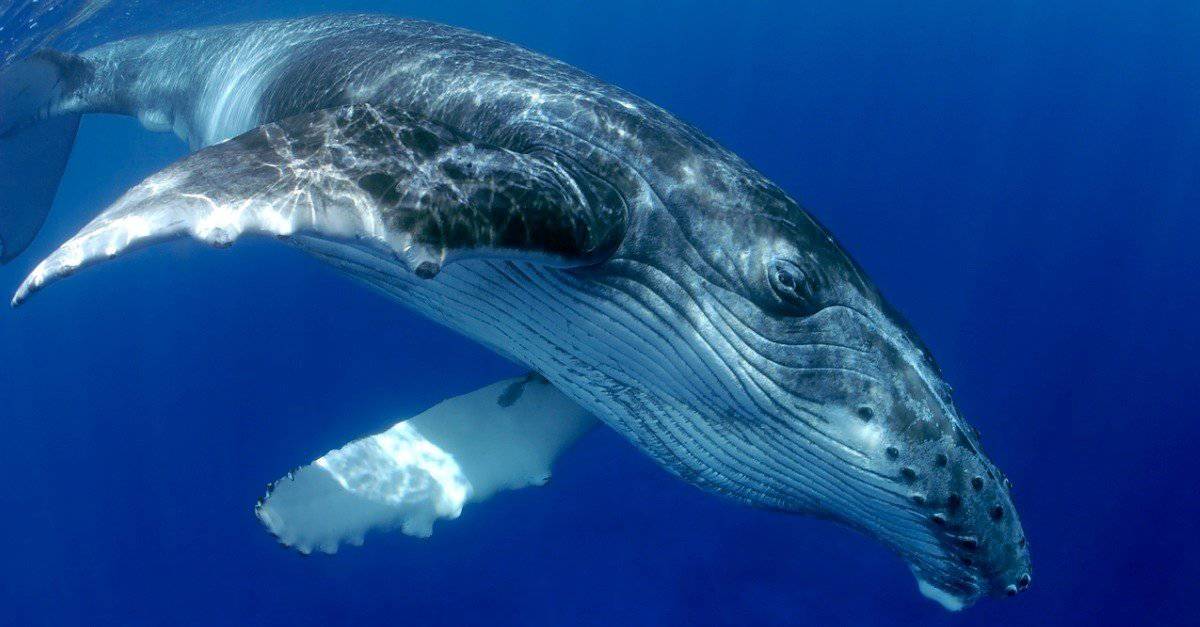
The Humpback whale, along with the Finback is a rare species in Georgia waters.
©iStock.com/Yann-HUBERT
The rarest animals in Georgia are all on the Endangered Species List like those described above. Unfortunately, we could make many additions, including the Indiana bat, Amber and Etowah Darters, Conasauga Logperch, West Indian Manatee, Hawksbill and Kempis Ridley Sea Turtles, Altamaha Spinymussel, and the Finback and Humpback whales. All are protected by federal law, and conservation plans are in place to try to not only save but also increase these species.
Snakes in Georgia
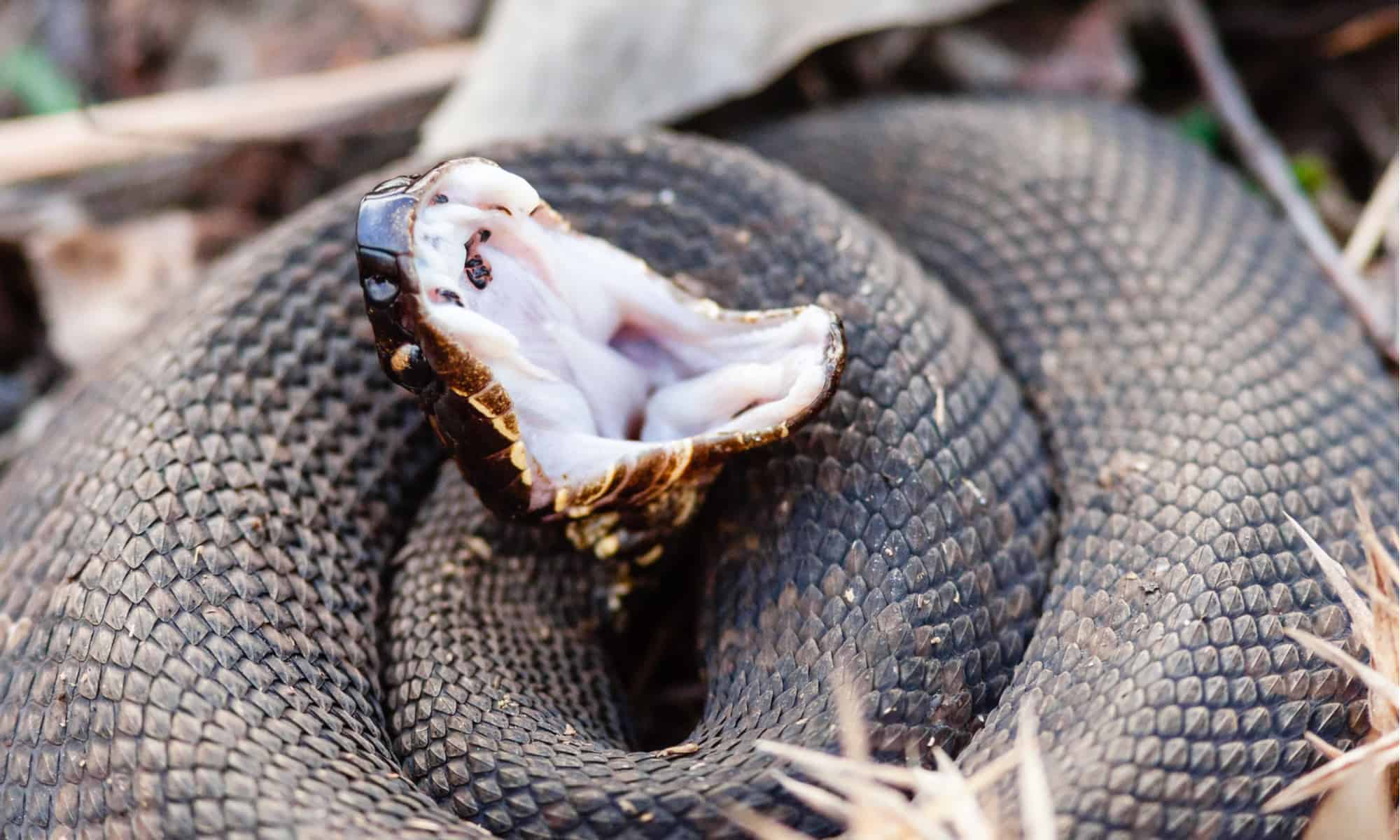
The Cottonmouth rattlesnake got its name from its all-white mouth.
©Marcum Havens/Shutterstock.com
Georgia is home to 46 different kinds of snakes and is one of the most snake-heavy states in the country thanks to its large coastal plain that supports a large variety of snake species. Beyond the eastern diamondback rattlesnake discussed above, Georgia is home to six different venomous snakes, which include three rattlesnake species. It is illegal to kill nonvenomous snakes in Georgia. Deaths from snake bites are rare, but it does pay to be aware of different snakes that can pose increased risks. The following snakes in Georgia are venomous:
- Cottonmouth
- Timber Rattlesnake
- Eastern Diamondback Rattlesnake
- Copperhead
- Pigmy Rattlesnake
- Eastern Coral Snake
Native Plants in Georgia
There are 12 different climate zones in Georgia, and each supports different varieties of plant and animal lifeforms. The state of Georgia is also well-known for its hospitality, and it seems this even transcends as well to the plants. From the southern sugar maple to the mountain silverbell, the state of Georgia is welcoming to every person or plant.
Discover the Coldest Place in Georgia
The coldest place in Georgia is Roswell with an average maximum temperature of just 63 degrees Fahrenheit. While summers get very hot, the winters in Roswell drop to 35 degrees Fahrenheit or colder.
Flag of Georgia
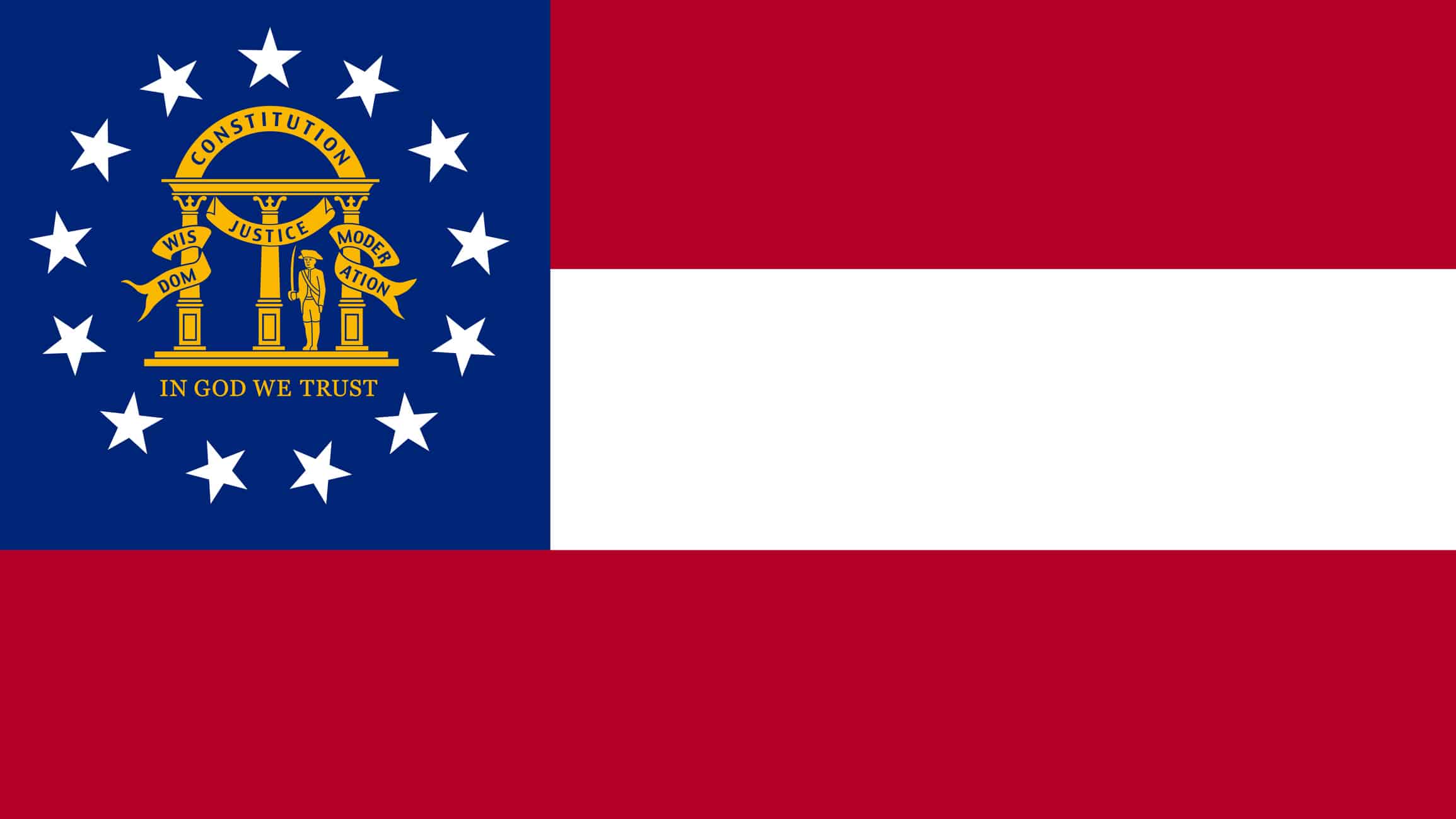
Georgia’s flag has three horizontal stripes, including a red-white-red triband and a blue canton by the side. The blue canton has a circle of 13 white stars at its center, with the gold-colored state Coat of Arms within the white stars.
©iStock.com/bndart
The flag of Georgia has a red-white-red horizontal triband and features a blue canton containing a ring of 13 white stars that encircle the state’s gold-colored coat of arms.
Georgia State Seal
The Georgia State Seal features three pillars of the judicial, executive, and legislative branches of government. It was designed in 1799.
More Articles Related to Georgia
Read about:
- extinct animals that lived in Georgia.
- scorpions in Georgia.
- the biggest alligator ever found in Georgia.
- the biggest tiger shark ever caught in Georgia.
- the best places to camp in Georgia.
- Georgia’s best bird-watching spots.
- the best fishing spots in Georgia in the summer.
- the longest biking trail in Georgia.
- Beetles Crawling in Georgia
- Discover the Largest Fish Ever Caught in Georgia
Georgian Animals

Admiral Butterfly
Stunningly beautiful wings
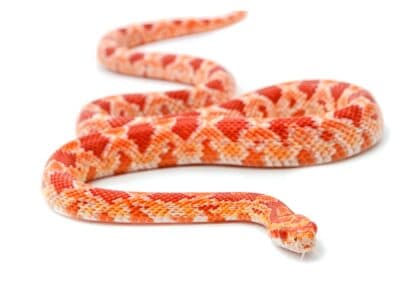
Albino (Amelanistic) Corn Snake
Albino corn snakes make great beginner snakes.
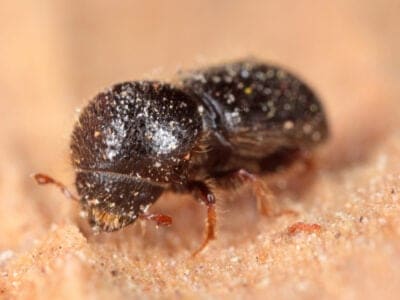
Ambrosia Beetle
The ambrosia beetle forms a symbiotic relationship with the ambrosia fungi
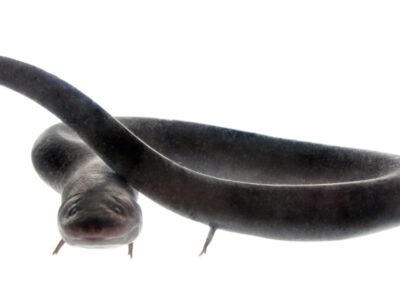
American Eel
Don't eat raw eel! Their blood is poisonous to humans when consumed raw.

Armyworm
They are so named because they "march" in armies of worms from one crop to another in search of food
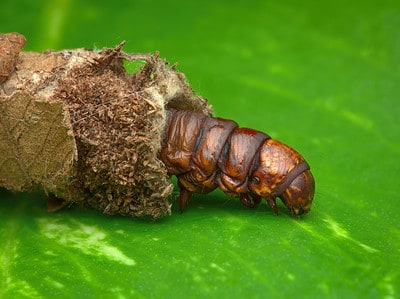
Bagworm Moth Caterpillar
They continually enlarge their protective cases

Banded Water Snake
Some water snakes defend themselves violently.

Beewolf wasp
They hunt bees
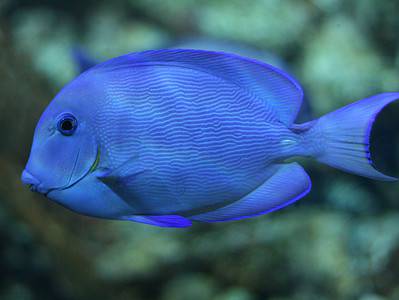
Blue Tang
One of the most colorful members of the genus Acanthurus
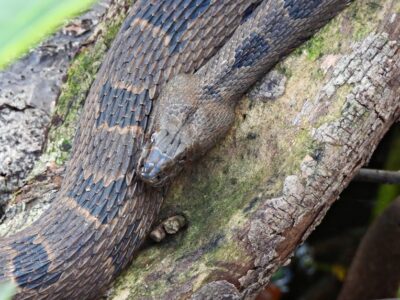
Brown Water Snake
Has more scales than any other water snake on the continent: 27 to 33 rows of dorsal scales!
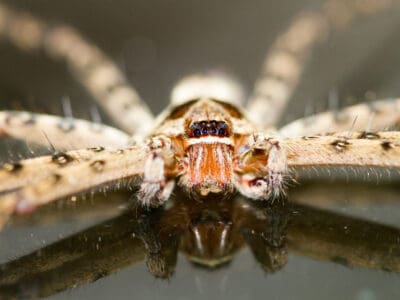
Cane Spider
Cane spiders don't spin webs to catch prey

Clearnose Skate
The skate with translucent nose patches

Common Yellowthroat
The Common Yellowthroat stays close to the ground and uses stealth to survive!
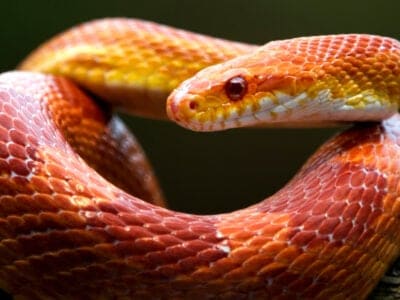
Corn Snake
Corn snakes are partly arboreal and are excellent climbers.

Crocodylomorph
Crocodylomorphs include extinct ancient species as well as 26 living species today.
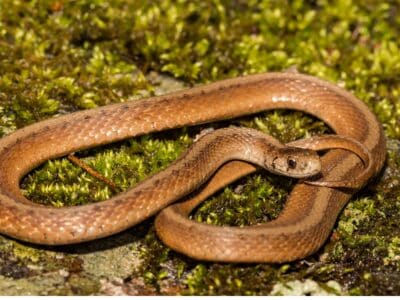
De Kay’s Brown Snake
They have specialized jaws for removing snails from shells.
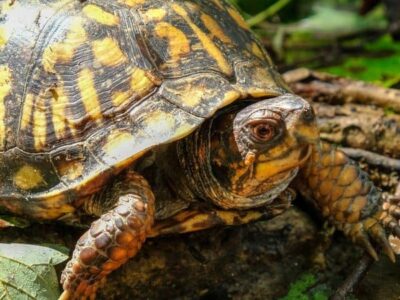
Eastern Box Turtle
When injured or damaged, the shell of the eastern box turtle can regenerate

Eastern Chipmunk
The name chipmunk is derived from an Ojibwe word that means “one who descends the trees headfirst.”

Eastern Diamondback Rattlesnake
This is the biggest venomous snake in North America, with a few that reach 8 feet long.
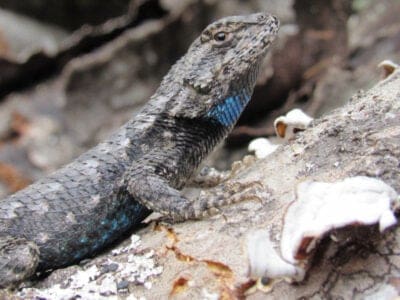
Eastern Fence Lizard
Females are usually larger than males.
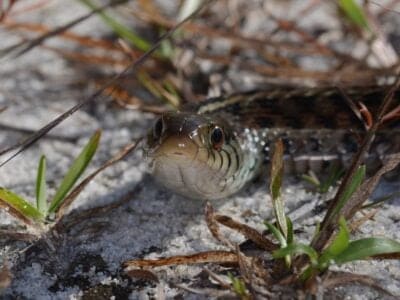
Eastern Glass Lizard
When the glass lizard loses its tail it can grow another one. But the new tail lacks the markings of the old one and is usually shorter.

Eastern Hognose Snake
Eastern hognose snakes are venomous, but only to frogs and toads.

Eastern Rat Snake
Rat snakes are medium-to-large, nonvenomous snakes that kill by constriction.
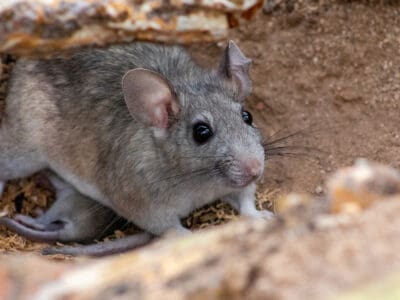
Eastern Woodrat
The eastern woodrat mating ritual involves a potentially deadly fight between the male and female before reproduction begins!

Flea
Adult fleas can jump up to 7 inches in the air
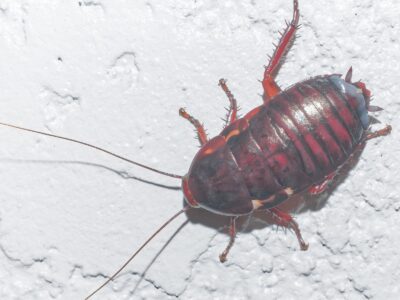
Florida Woods Cockroach
Often found on palmetto trees
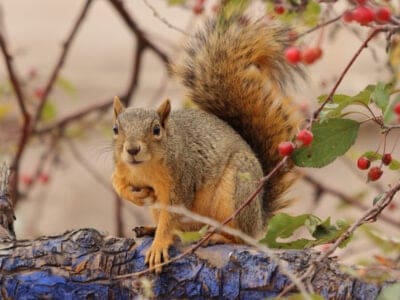
Fox Squirrel
Although it is a tree squirrel, it spends most of its time on the ground.

Goldcrest
The goldcrest never starts moving and needs to consume for most of the day to survive. Therefore, in the colder months, it's best that eat 90% a day.
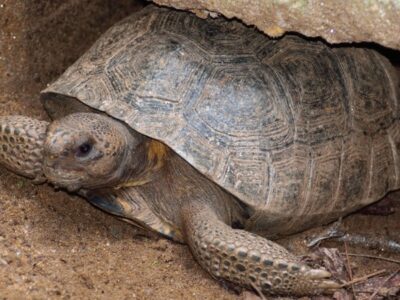
Gopher Tortoise
It is the only species of tortoise native to Florida.

Groundhog (Woodchuck)
They whistle to each other to warn of approaching danger!
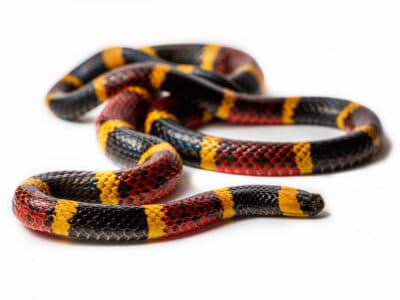
Harlequin Coral Snake
Red touches yellow kills a fellow, red touches black a friend of Jack.

Indigo Snake
Indigo snakes use brute force to overpower their prey.

Jack Crevalle
One of the biggest species in the Caranx genus

Jackrabbit
They can run as fast as 45 mph.

Kentucky Warbler
The Kentucky Warbler appears to wear bright yellow cat-eye glasses!
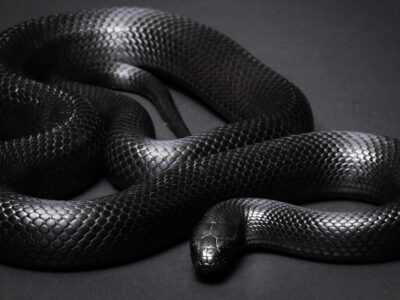
King Snake
King Snakes eat other types of snakes.
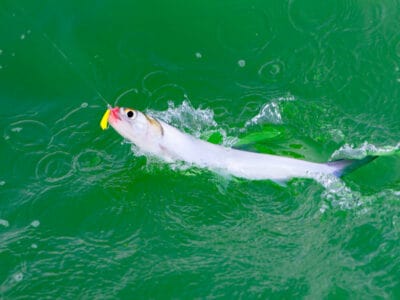
Ladyfish
Ladyfish are aggressive fighter when hooked, making them a favorite of anglers.

Mealybug
They have a symbiotic relationship with ants.

Mockingbird
Mockingbirds are incredible mimics that can learn hundreds of songs!
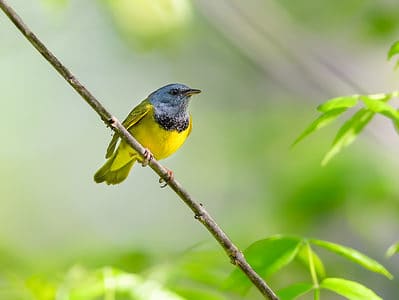
Mourning Warbler
The Mourning Warbler was named for its gray head, which resembles a mourning veil!
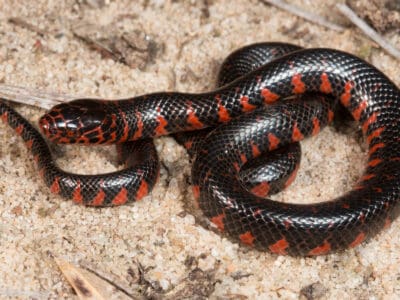
Mud Snake
Mud snakes can lay over 100 eggs at a single time!

Nematode
Nematodes range in size from 1/10 of an inch to 28 feet long

Northern Water Snake
Northern watersnakes’ teeth help them nab fish as they swim by.

Orb Weaver
Females are about four times the size of males

Owl
The owl can rotate its head some 270 degrees
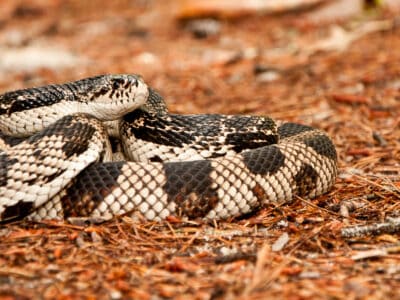
Pine Snake
Pine snakes bluff with the best, trying to scare you away.
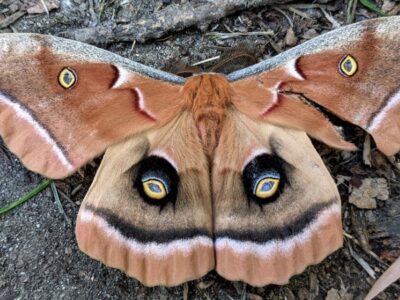
Polyphemus Moth
The Polyphemus moth doesn’t and can't eat, except when it's a caterpillar!

Pompano Fish
They are bottom-feeders

Pygmy Rattlesnake
Pygmy rattlesnakes’ rattle is so small it can only be heard from about three feet away.
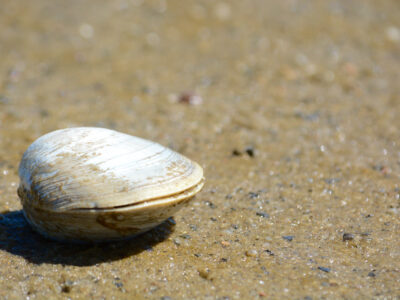
Quahog Clam
Their hinged shell protects their soft body
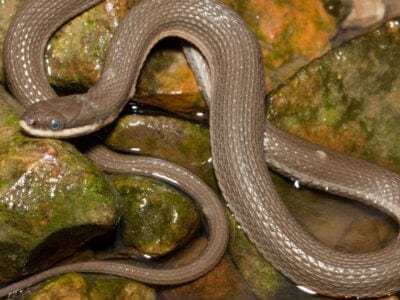
Queen Snake
Queen snakes have armor-like scales on the top of their head

Rat Snakes
Rat snakes are constrictors from the Colubridae family of snakes.

Red-Bellied Woodpecker
Red-Bellied Woodpeckers will often steal the nests of other birds.
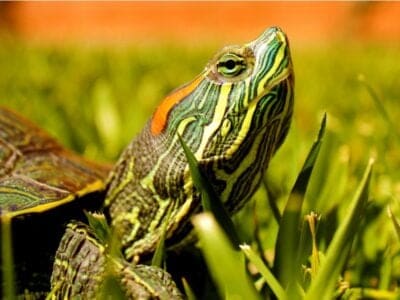
Red-Eared Slider
Sliders spend lots of time basking in the sun. As cold-blooded animals, they need the sun to heat up.
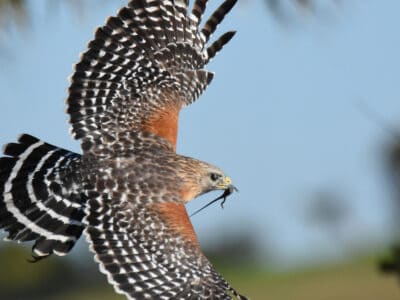
Red-Shouldered Hawk
Red-Shouldered Hawks reuse the same nesting area each year.

Rooster
Will mate with the entire flock!

Rough Earth Snake
It has a pointed snout that is uses to burrow into moist soil.
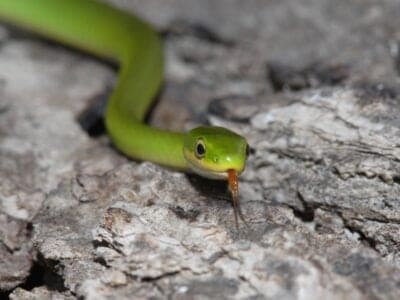
Rough Green Snake
Rough green snakes are great pet snakes because they're low-maintenance.
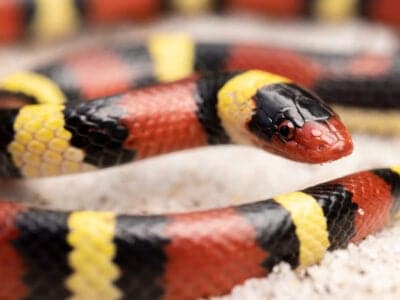
Scarlet Kingsnake
Scarlet kingsnake’s pattern is an example of Batesian mimicry.
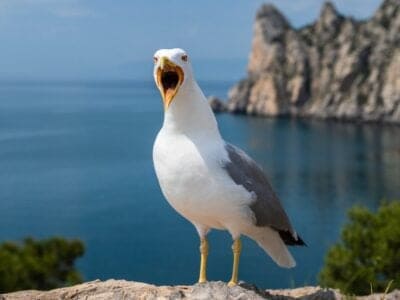
Seagull
Some gulls are capable of using tools

Smallmouth Bass
A fierce fighter!

Smokybrown Cockroach
Has up to 45 eggs per egg case
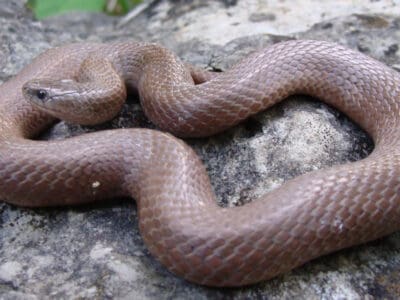
Smooth Earth Snake
Valeria Biddle Blaney (1828-1900) collected the first specimen in Maryland.

Southern Black Racer
These snakes live underground, beneath piles of leaf litter or in thickets, and they are expert swimmers.
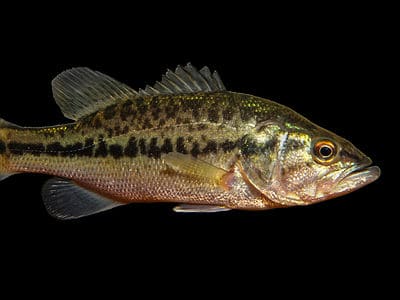
Spotted Bass
Spotted bass tend to congregate in schools unlike other types of bass fish.

Tree Cricket
They make music with their wings

Wryneck
They feign death by making their bodies limp and closing their eyes.
Georgian Animals List
- Admiral Butterfly
- Agkistrodon Contortrix
- Albino (Amelanistic) Corn Snake
- Ambrosia Beetle
- American Eel
- Armyworm
- Bagworm Moth Caterpillar
- Banded Water Snake
- Beewolf wasp
- Blue Tang
- Brown Water Snake
- Cane Spider
- Chilean Recluse Spider
- Clearnose Skate
- Common Yellowthroat
- Corn Snake
- Crocodylomorph
- De Kay’s Brown Snake
- Eastern Box Turtle
- Eastern Chipmunk
- Eastern Diamondback Rattlesnake
- Eastern Fence Lizard
- Eastern Glass Lizard
- Eastern Hognose Snake
- Eastern Rat Snake
- Eastern Woodrat
- Flea
- Florida Woods Cockroach
- Fox Squirrel
- Goldcrest
- Gopher Tortoise
- Groundhog (Woodchuck)
- Harlequin Coral Snake
- Indigo Snake
- Jack Crevalle
- Jackrabbit
- Kentucky Warbler
- King Snake
- Ladyfish
- Mealybug
- Milk Snake
- Mockingbird
- Mourning Warbler
- Mud Snake
- Nematode
- Northern Water Snake
- Orb Weaver
- Owl
- Pine Snake
- Pine Snake
- Polyphemus Moth
- Pompano Fish
- Pygmy Rattlesnake
- Quahog Clam
- Queen Snake
- Rat Snakes
- Red-Bellied Woodpecker
- Red-Eared Slider
- Red-Shouldered Hawk
- Rooster
- Rough Earth Snake
- Rough Green Snake
- Scarlet Kingsnake
- Seagull
- Smallmouth Bass
- Smokybrown Cockroach
- Smooth Earth Snake
- Southeastern Blueberry Bee
- Southern Black Racer
- Spotted Bass
- Swallowtail Butterfly
- Tree Cricket
- Wryneck
Animals in Georgia FAQs (Frequently Asked Questions)
When do snakes come out in Georgia?
Snakes generally come out from late March through April in Georgia. In areas of the state that are warmer during winter and early spring such Savannah, they’ll emerge earlier. In Piedmont, they’ll take until later in April to begin reaching higher activity levels.
What kind of animals live in Georgia?
Mammals, reptiles, amphibians, birds, and fish live in Georgia. Some of the most well-known inhabitants include black bears, brown thrashers, green tree frogs, beavers, and the eastern cottontail rabbit. The fox squirrel is also a notable Georgia native. Rodents such as the marsh rice rat and meadow jumping mouse live in Georgia as well.
What dangerous animals live in Georgia?
The most dangerous animals living in Georgia are the eastern diamondback rattlesnake, the black widow spider, the snapping turtle, and the copperhead snake.
What wild animals are in Georgia?
There are all kinds of wild animals in Georgia from coyotes to cottonmouth snakes to sandhill cranes.
There are strange animals like the one toed amphiuma. This is a type of salamander that looks like it has a single toe at the front of its body. It lives in muddy areas along the coast of Georgia. Though it can grow as long as 13 inches, it is one of the rarest sights on the coastline.
What wild animals are in Atlanta?
Atlanta, the capitol of Georgia, has its own collection of wild animals. Foxes, raccoons, mice, rats, pigeons bats, and geese all live in or around Atlanta.
What kind of predators are in Georgia?
One of the most notable predators in Georgia is the black bear. Black bears are strong enough to subdue prey including elk, deer and young moose. They also eat plants, insects, fish, grass and larvae. These bears will eat what is most plentiful in their habitat at the time.
Another well-known predator in Georgia is the bobcat. Bobcats are the most common wildcat living in America. These medium-sized cats are fast and agile making them excellent predators. In Georgia they hunt deer, rabbits, hares, birds, small rodents and even bats.
The great horned owl another well-known predator hunts for small rodents including mice and rats. They also eat skunks, rabbits, birds, fish, lizards, hawks, and even smaller owls. Its large and powerful talons combined with its excellent hearing and sight make it one of the most formidable predators hunting at night.
Coyotes are also notable predators in Georgia. Coyotes hunt white-tailed deer, elk, rabbits, bighorn sheep, doves, fish, and even turtles. If a coyote is traveling with a pack, the individuals in the group work to subdue larger prey such as elks or white-tailed deer. But, if a coyote is hunting alone, it usually goes after more manageable prey like rabbits, birds, or fish. Coyotes sometimes scavenge meat from prey killed by another animal and left behind.
What aquariums are in Georgia
Georgia is home to the United States’ largest aquarium: the Georgia Aquarium. In addition, you may want to visit the Flint RiverQuarium which is home to a rare albino alligator.
What kind of spiders are in Georgia?
Georgia is home to a number of spiders. One recent entrant to the state is the Joro spider, which was first reported in Georgia in 2014. Since then its spread rapidly. Also in the state is the twin-flagged jumping spider, ravine trapdoor spider, and dotted wolf spider. For a full listing of the most interesting spiders in the state make sure to read ‘10 Spiders in Georgia.’




